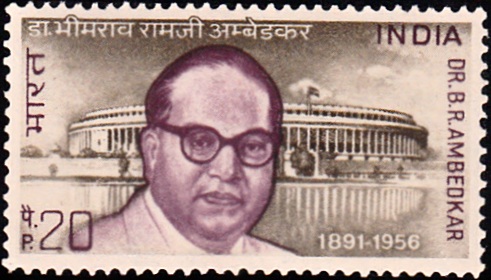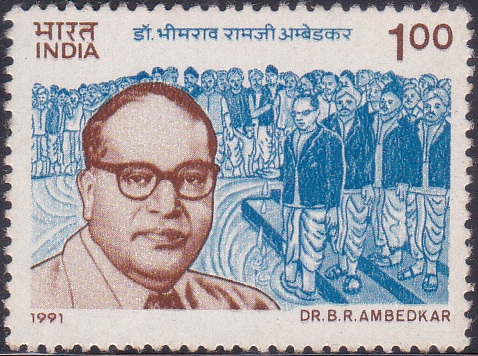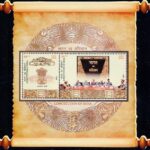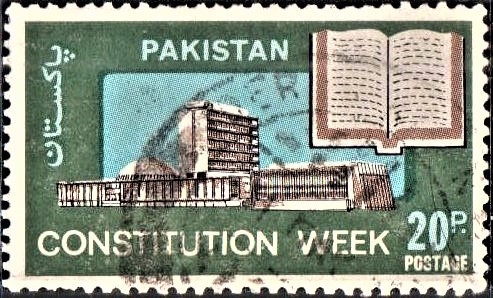
Dr. B. R. Ambedkar 1973
A commemorative postage stamp on the Birth Anniversary of Dr. Bhimrao Ramji Ambedkar, 1st Minister of Law and Justice in India (1947-51) and Chairman of the Constitution Drafting Committee (1947-50) :
Issued on Apr 14, 1973
Issued for : His memory is cherished like an avatar by the whole of the Depressed community. Dr. Ambedkar, whom history will undoubtedly reckon amongst the great emancipators of humanity will be a source of inspiration to the nation in its march towards the goal of social equality. The P & T Department feels honoured to bring out a commemorative stamp of this great son of India during the 25th year of the country’s Independence.
“Glory to those who would keep on their struggle for the Liberation of the enslaved in spite of heavy odds, carping humiliations, storms and dangers till the down-trodden secure their human rights.” – Dr. Ambedkar.
Description of Design : The design of the stamp is horizontal and depicts the portrait of Dr. B.R. Ambedkar. The Parliament House is seen in the background.
The design of the stamp is adapted from the original prepared by Shri Charanjitlal, Artist, Posts & Telegraphs Directorate, New Delhi.
Type : Stamp, Mint Condition
Colour : Raw Sienna and Red Purple
Denomination : 20 Paise
Overall size : 4.06 X 2.28 cms.
Printing size : 3.80 X 2.00 cms.
Perforation : 14 x 14½
Watermark : Coated unwatermarked P.G. Stamp Paper
Number Printed : 10,00,000
Number per issue sheet : 50
Printing Process : Photogravure
Designed and Printed at : India Security Press
Name : Bhimrao Ramji Ambedkar (Babasaheb)
Born on Apr 14, 1891 at Mhow, Indore, Madhya Pradesh [then Maharashtra], India
Died on Dec 6, 1956 at Delhi, India
About :
- Dr. Ambedkar belonged to the tradition of progressive social thinkers in India – the tradition of Ram Mohan Roy, Mahatma Phule and others. Essentially a social thinker, having deep understanding of political and economic problems, he provided a philosophy to the social revolt in India. His social philosophy combines the rational and scientific attitude with a passion for the uplift of the depressed classes.
- Bhimrao Ramji Ambedkar was born on 14th April 1891 in a poor Mahar family hailing from the state of Maharashtra. In the midst of the harsh and severe social disabilities of the untouchables during those times, that young Bhimrao should have elevated himself to be a barrister and a Ph.D. was in itself an out standing marvel. After his education, Dr. Ambedkar distinguished himself in many fields of public life until eventually he came to be reckoned amongst the foremost personalities of his time. Eminent constitutional lawyer, authority on economic and political issues, statesman, author, agitator, architect of the Indian Constitution, during his career of 30 years, Dr. Ambedkar adorned diverse fields.
- Yet, it is principally as the symbol of social revolt that Dr. Ambedkar‘s memory will be cherished by all the unprivileged and suppressed classes of our society. When he started his political career 50 years ago, the untouchables were dumb and downtrodden. By 1956 when he died, by the ceaseless hammer of his propaganda, and by his skilful political engineering, he had succeeded in raising his caste fellows from the dust to the dignity of an equal citizenship. This elevation of 10 crores of the down·trodden from the state of near slavery to manhood is in itself a glorious chapter in the history on human freedom. He advocated cleanliness and self respect to his people and enjoined them to send their children to school, to treat the womenfolk with respect. He constantly reminded them that it was only by self-elevation that they would be able to raise themselves and their community.
- The Chowdar Tank Struggle at Mahad in 1927 and the Nasik Kalaram Temple Entry Agitation in 1930 were two of the historic struggles led by Dr. Ambedkar. Dr. Ambedkar had been mentioning for about 30 years the possibility of the Depressed community abjuring Hindu religion if necessary, and eventually, just a little before his death, he embraced Buddhism followed by hundreds of his followers all over the country.
- Although he was the first revolutionary leader to emerge from the down-trodden untouchables in the last twenty five hundred years and even though his main role that of the Great Emancipator of the Oppressed, he was a fervent nationalist. It was the constant refrain of his preaching to his community that their wrongs would not be righted as long as the British power remained in India. After the advent of independence when the Constituent Assembly met, this “enfant terrible” of Indian politics was nominated to be the Chairman of the Drafting Committee of the Constitution. On the 29th April 1947 the Constituent Assembly declared to the world “Untouchability in any form is abolished and the imposition of any disability on that account shall be an offence.“ Dr. Ambedkar‘s outstanding capabilities were now being yoked to the monumental constructive purpose of drawing up the Constitution of a free India. In the words of the late Jawahar Lal Nehru :
“Dr. Ambedkar will be remembered mostly as the symbol of revolt against all the oppressing features of Hindu society. His virulent opposition to these oppressive features had kept people’s mind awake. Although he was a highly controversial figure, he played a very constructive and very important role in making of the Constitution of India and Hindu Law Reform. He revolted against something which every body should revolt against.”
- Dr. Ambedkar‘s last important contribution to public life was the painstaking work that he did as Law Minister of the First Govt. of free India for enacting the Hindu Code.








[…] 13 committees for framing the Constitution including a Drafting Committee under the Chairmanship of Dr. B. R. Ambedkar. On the basis of the reports of these committees, a draft of the Constitution was prepared by the […]